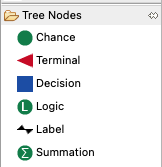3.7 Nodes in TreeAge Pro
Decision trees can include nodes with a number of different node types. This section lists the node types and their typical usage. The Tree Diagram Editor Palette displays all the available node types.

-
Chance: Used to represent a situation with an unknown outcome. Each branch of the chance node represents one of the outcomes. There must be a branch for every possible outcome, and each branch will include a probability expression for the likelihood of that outcome. The hashtag (#) can be used for one of the branch probabilities, which is calculated as the complement of the sum of all other probability expressions.
-
Terminal: Used to terminate endpoints in a model. All endnodes (no branches) must be terminal nodes. In a decision tree, a terminal node represents the end of a scenario, and payoff values are required to place value(s) on that scenario. In a Markov model, a terminal node represents the end of a cycle, and a jump state is used to return the cohort to a health state to start the next cycle. In DES models, terminal nodes function the same as in Markov models.
-
Decision: Used to represent a decision point within a model. Each branch represents a strategy which will be evaluated separately to determine the optimal strategy at that decision node. It is typical for a model to contain a single decision node as the left most node in the model (the root node).
-
Logic: Used like a chance node with an unknown outcome. However, each branch will have a logical expression instead of a probability expression. Logical expressions are checked from the top branch down. The model will flow to the first branch with a logical expression that evaluates to true. It is common to use the hashtag (#) for the bottom branch for when all logical expressions for the other branches are false.
-
Label: Used to simply flow from a node to its one and only branch. It functions the same as a chance node with a single branch with probability of 100%. This is commonly used to separate dependent calculations, so the calculations at the label node are complete before the calculations are performed at the branch node.
-
Summation: Used to sum the expected values (EVs) of all branches within a decision tree, rather than use a weighted average as is done for chance nodes. This is commonly used when there are multiple separate value calculations and the sum of those values represents the total EV. For example, branches could be used in a legal model for compensatory damages and punitive damages, such that the total value is the sum.
